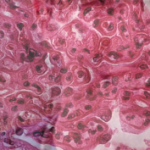Dr. Clowse also referred to the ACR guideline in discussing appropriate contraceptive options for patients, medications that are safe for pregnant or lactating mothers, and even how to counsel patients on the use of assistive reproductive technologies.
Pediatric Rheumatology
Eveline Wu, MD, MSCR, associate professor of pediatric rheumatology at University of North Carolina Children’s Research Institute, Chapel Hill, provided a pediatric rheumatology review geared toward the adult rheumatologist. Dr. Wu began her talk by noting how important it is for adult and pediatric rheumatologists to collaborate, especially given the scarcity of physicians practicing pediatric rheumatology—in fact, about 10 states have no pediatric rheumatologists at present.
Dr. Wu next addressed the topic of juvenile arthritis-associated temporomandibular joint (TMJ) disease. Among the subtypes of juvenile idiopathic arthritis (JIA), patients who are rheumatoid factor negative and with polyarticular disease are at particularly high risk of TMJ involvement, although all categories of JIA are at risk and about 40–80% of patients with JIA will have TMJ arthritis. This is important because TMJ disease can cause abnormal dentofacial development and significant facial disabilities, including orofacial pain, reduced TMJ mobility and impaired mastication function.
The clinical evaluation should include palpating the joint to try to elicit tenderness, noting clicking or crepitus with joint movement and identifying asymmetry of the face at rest and deviation with mouth opening. Magnetic resonance imaging with contrast is the gold standard of imaging, and intra-articular corticosteroid injections and intra-articular lavage without corticosteroid are effective treatments.
The second main clinical topic Dr. Wu discussed was JIA-associated uveitis, which is the most common extra-articular complication of the disease. In the SYCAMORE study, patients with JIA-associated uveitis who were age 2 years or older and on a stable dose of methotrexate were randomized to receive either adalimumab or placebo. After two years of follow-up, patients receiving adalimumab therapy had lower rates of treatment failure (27% vs. 60%, respectively), indicating the efficacy of this treatment.
Dr. Wu concluded her talk with a discussion of multi-system inflammatory syndrome in children (MIS-C), a rare but serious condition that shares many features of Kawasaki disease and has emerged with the COVID-19 pandemic. The ACR clinical guidance document on MIS-C describes this disease as a condition characterized by fever, inflammation and multi-organ dysfunction that manifests late in the course of SARS-CoV-2 infection.13 Dr. Wu explained that much remains to be understood about MIS-C and that this disease will be one of the most important issues related to COVID-19 in the world of pediatric rheumatology.


